School at Home
Parent Support: Resources to help your child’s learning at home
Teaching from home? We’re here to help. Here’s a list of free resources, how to’s, and parent videos to help you support your child’s maths learning.
Explore textbooks and workbooks. Free access to Answer Guides with every purchase.
Shop NowMaths Activity Time
Try these primary maths activities with your children at home.
Select your child's age category
Ages 5–6
Making Subtraction Stories (Ages 5–6)
Lesson objective: Make subtraction stories and represent them in subtraction sentences
There are a few ways to add an extra challenge to this activity. Ask your child to use a variety of strategies to show subtraction. Can they explain their subtraction strategies? Can they use number bond diagrams to show their subtraction story? Can they write a subtraction equation?
If your child is struggling, let them use concrete materials. But encourage them to differentiate by colour and to phrase the answer correctly.
You could do this activity with any year group by adjusting the numbers. Many children are very good at computation but they’re not as strong when it comes to linking abstract maths with the real world.
Asking learners to write stories and provide context for equations helps them bridge the gap between school maths and maths they think is relevant in their life.

Using Prior Knowledge (Ages 5–6)
Lesson objective: Apply knowledge of addition and subtraction to solve problems.

Ask your child to work out a solution to this problem and explain their thinking. This helps build up their reasoning skills. They can show their thinking by drawing pictures and writing out the number sentence they used to find their answer. Extend this task by asking your child to make their own word problem using the two given numbers. Encourage them to lean on their prior knowledge of addition and subtraction. Show them how to solve the problem by drawing objects to help them add or subtract.
Counting Objects to 10 (Ages 5–6)
Lesson objective: Count similar objects up to 10 with accuracy and fluency
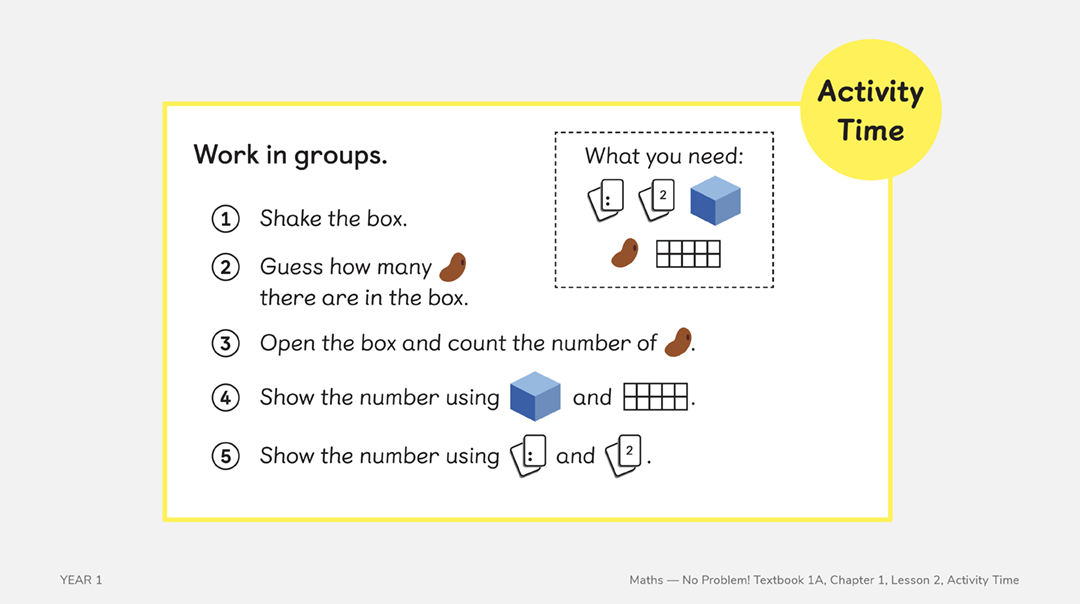
Place a small number of beans into a box and shake it. Ask your child to identify how many beans you are shaking in a box.
Don’t have beans? Any small solid object will do. Just make sure they’re counting the same object: buttons, macaroni, sweets. It’s best to avoid using an array of objects in the box at the same time.
Once they think they know the answer, explain that one bean is equal to the number 1. Ask them to show you their estimated number using their own set of beans on a ten frame. Then ask them to show you by using digit cards.
Extend the task by asking them to focus on the type of sound the box makes when you increase or decrease the number of beans. Ask how that might be helpful.
Ages 6-7
Arranging Counters (Ages 6–7)
For this activity, make sure your child has access to concrete materials. If you don’t have counters in your home, beads, coffee beans or buttons are good substitutes. The important thing is having objects your child can physically move and arrange.
To add a challenge, ask your child to try the activity with different amounts of counters. What do they notice about odd and even numbers? Are they able to make generalisations about the amount of counters and the number of possibilities for equal rows?
Focus on looking for multiple ways to express each amount of counters. This helps develop your child’s relational understanding skills.
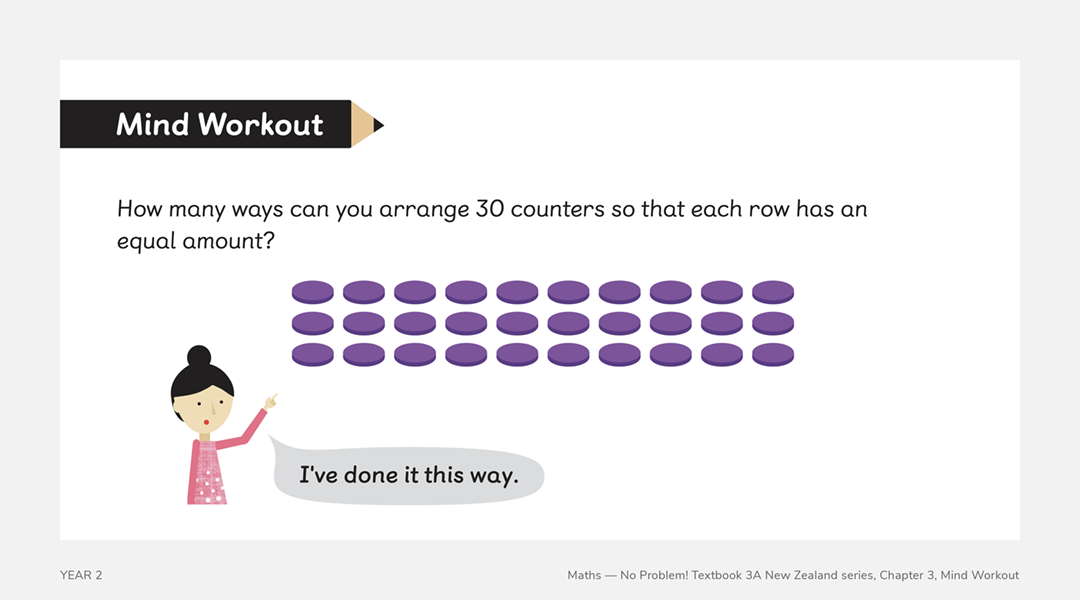
Drawing Clock Hands (Ages 6–7)
Lesson objective: Draw hands on an analogue clock to show the correct time

Before diving into this activity, give your child an analogue clock. Ask them to display 7:45pm and give them a minute or two to work this out. If they need a prompt, remind them to think about what the hour hand would look like.
Ask your child what 4:15 would look like, paying special attention to the hour hand. Tell them that your friend says 4:15 is close to 4:30 so the hour hand should be in the middle of 4 and 5. Is this correct? Ask them to discuss their thinking.
Now onto the activity. This activity is for groups of three or four, but you can easily modify it to work in pairs.
Ask your child to think of a time when they do their favourite activity. It could be football, piano lessons or going to the park on Sundays. Once they’ve decided on a time, ask them to tell you (or their sibling) more about this activity and display the time on their clock.
Place Value (Ages 6–7)
Lesson objective: Know the place value of each digit in a 2-digit number
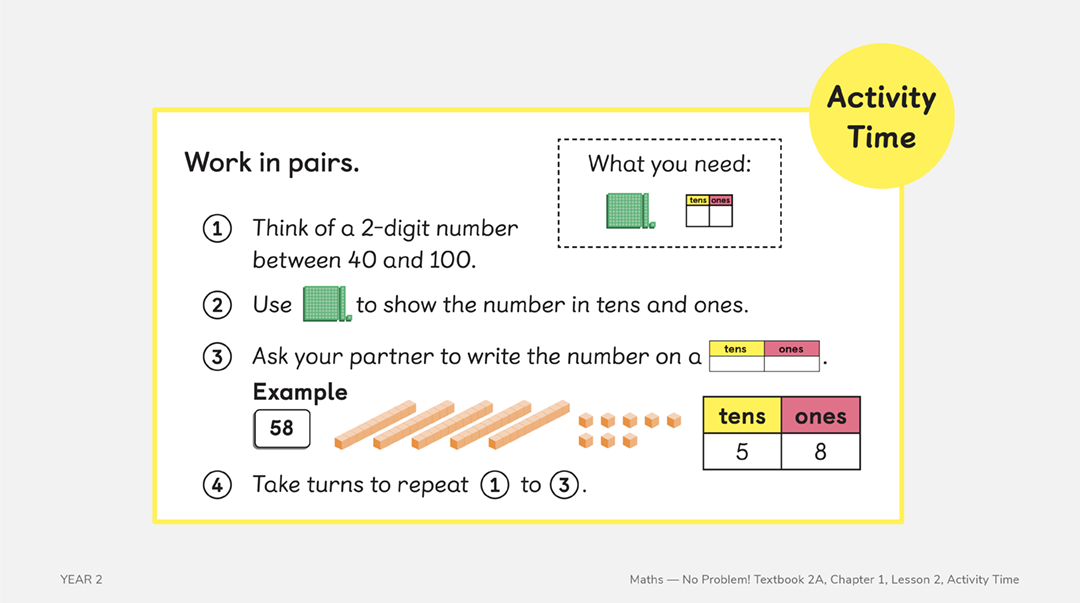
Ask your children to work in pairs, it’s time to play the place-value game!
Ask one child to think of a number between 40 and 100 and use Base 10 materials to show the number. Ask their sibling to write the number on a place-value chart. Encourage them to switch roles each time the activity is repeated.
Can they use Base 10 materials to represent and read numbers? Can they use a place-value chart to represent numbers? Can they use a number bond diagram to represent numbers? Can they determine what each digit stands for in 2-digit numbers?
If your child needs supprt, have them represent the numbers using Base 10 materials before using the different approaches.
For advanced learners, ask them to write an explanation for why the place value chart uses 5 and 8 rather than 50 and 8.
(Top tip: Download Visualiser to get the Base 10 materials: hundreds, tens and ones).
(Ages 7–8)
Adding With Renaming (Ages 7–8)
Lesson objective: Add two 3-digit numbers with renaming the ones and tens
This activity encourages children to move at their own pace while practicing their skills. It’s especially relevant for struggling learners.
Here, Base 10 blocks are helpful for adding and constructing numbers. If you don’t have access to Base 10 materials at home, you can download Visualiser, our free app for iPad. Or cut and fold your own with this free printable resource.
Challenge your child to find the greatest sum or the smallest sum and ask them to explain their thinking. Can they make sums greater than 1000 or less than 1000? What do they notice? What generalisations can they make?
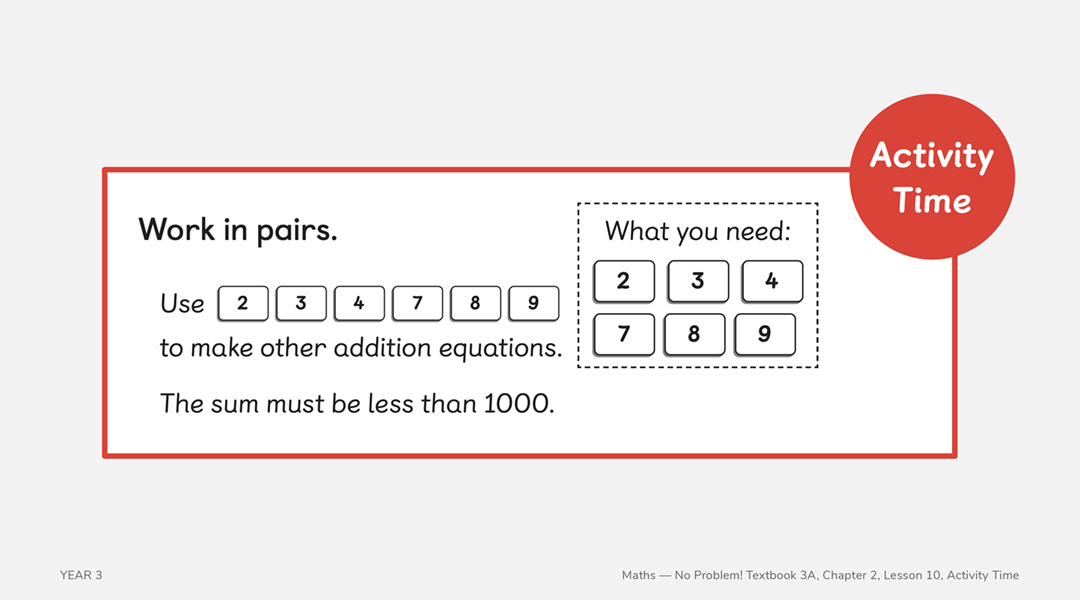
Adding Coins to Make an Amount (Ages 7–8)
Lesson objective: Add different combinations of coins to make an amount
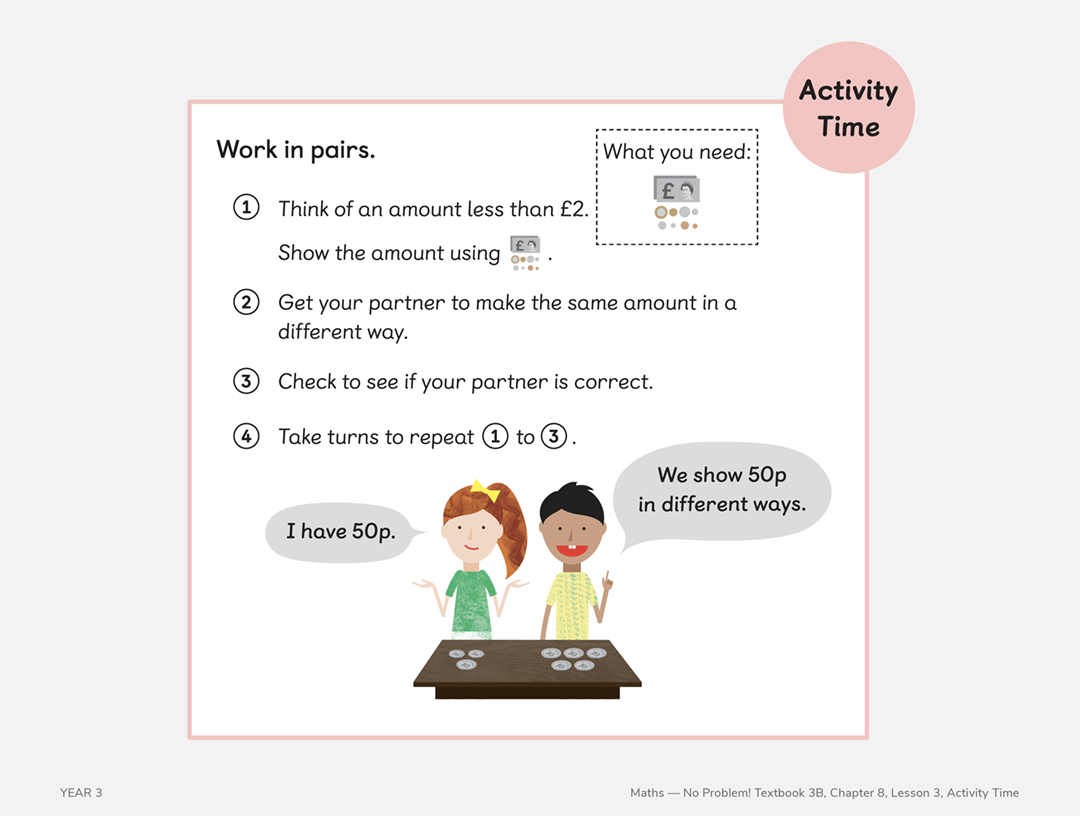
Before jumping into this activity, give your child a variety of coins to explore ways of making £2.80 using different combinations.
Ask them what is the most number of coins we can use to make £2.80? What about using the least number of coins? Is it possible to show the amount using fewer than five coins?
If you have more than one child at home, ask them to work in pairs and record their answers, and take turns checking whether the answers are correct.
Show your child this activity and start by asking them to think of an amount that’s less than £2. Encourage them to think of all of the ways they could make their chosen amount of money. Three or more ways is a clever day!
Measuring and Comparing Time (Ages 7–8)
Lesson objective: Measure and compare time in seconds

This is a fun outdoor activity that would suit families with more than one child learning from home.
It focuses on developing your child’s measuring and comparing skills and is designed to be accessible to all learners. For learners who are still developing fine motor skills, use the timer on a phone.
Ask your children to work in pairs. Give them a stopwatch each and ask them to run a distance of 100 metres. Ask them to record each other's time using the stopwatch to find out who can run the distance quicker. Guide them to see that the learner with the lower number of seconds runs faster.
For advanced learners, ask them to show seconds on a number line with small markers for milliseconds. How many markers should there be?
Ages 8–9
Compare and Order Numbers (Ages 8–9)
Lesson objective: Compare and order 4-digit numbers
Here’s a fun activity that would suit families with more than one child learning from home.
Add a challenge to this activity by extending the comparison of three numbers using mathematical symbols, like greater than or less than symbols.
In this activity, each player takes more place value discs, however the majority of the discs are tens and ones. So, if a player has 10 tens they have a hundred.

Rounding Decimals (Ages 8–9)
Lesson objective: Round numbers with one decimal place to the nearest whole number
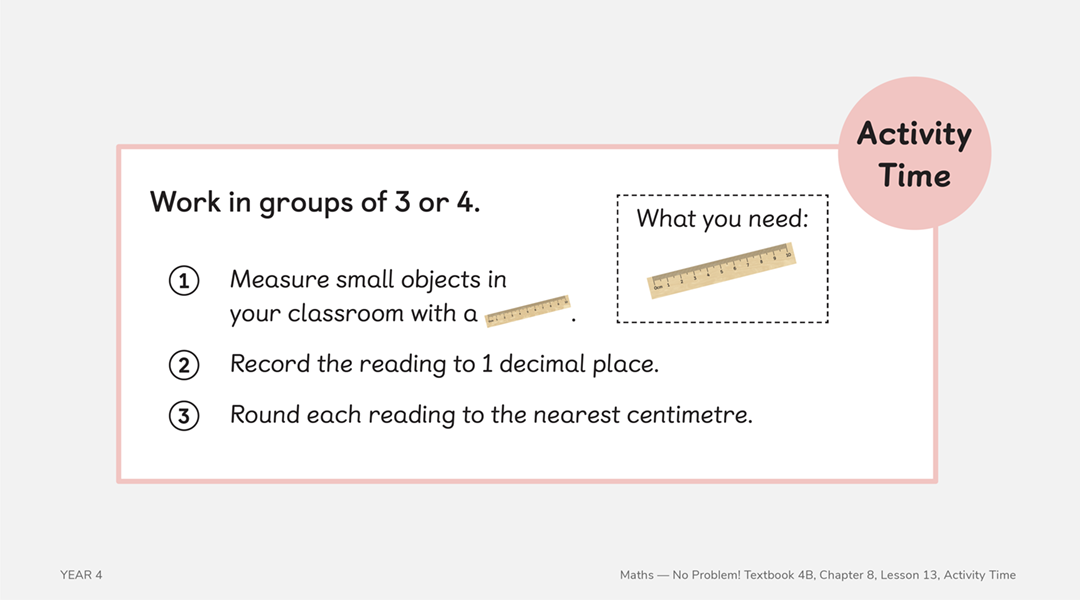
Before starting the activity, grab a ruler and draw a line that’s 0.9 cm. Ask your child to look at the ruler. Where is 0.9 cm? It is between which two numbers? Then ask them whether 0.9 is nearer to 0 or 1.
What else can we say about 0.9 cm? We can say that 0.9 cm is about 1 cm. We can also say that 0.9 cm is approximately equal to 1. Write the 'approximately equals to' sign out on a piece of paper. As 0.9 cm is not equal to 1 cm, we cannot use the equal sign, we can only use the 'approximately equals to' sign.
Once you’re confident your child has a good understanding of the concept, move on to the activity. This activity is for groups of three or four, but you can easily modify it to work in pairs.
Ask your child to measure small household objects with a ruler. Then, ask them to first record the number to one decimal place, and then round to the nearest centimetre.
Can they think of some rules for rounding numbers to the nearest whole number? If you have more than one child at home, allow them to talk in pairs before agreeing on some 'top tips' together.
Multiplying by 6 (Ages 8–9)
Lesson objective: Multiply by 6
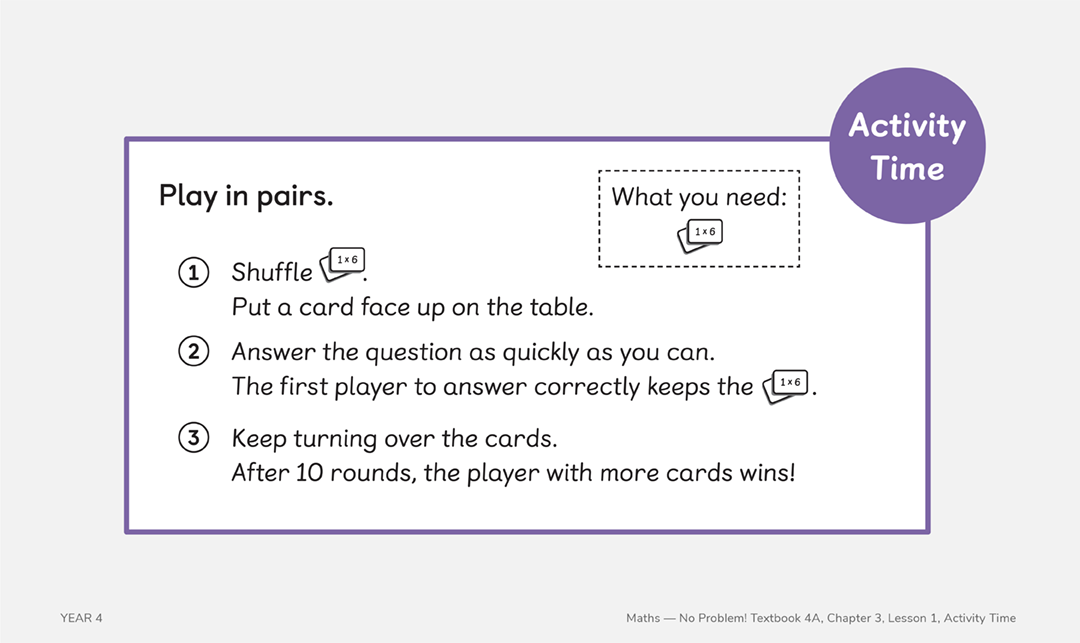
In pairs, let your children practice their 6 times tables by playing a game.
From a pile of shuffled playing cards, place a card face up on the table and see who can answer the fastest. After 10 rounds, the player with the most cards wins.
If a student needs additional support ask them first to use counters to make the 6 times table.
To challenge a student discuss ways of counting in sixes, for example, if you know the 3 times table you could just double them. You could also use the 2 times table; ask pupils how this might help.
(Top tip: This activity can be used for all of the times tables.)
Ages 9–10
Adding and Subtracting Decimals (Ages 9–10)
Lesson objective: Add and subtract decimals to find number pairs that add up to 1
If your child is struggling with this activity, check they know their number bonds to 10 (for example 8 + 2 = 10 or 3 + 7 = 10). Help them see how this idea is linked to making a total of 1 when adding decimals (0.8 + 0.2 = 1 or 0.3 + 0.7 = 1).
If they’re having trouble subtracting with regrouping, they can count on from the number until they reach 1 to find the number pair.
Looking to challenge your child further? Ask them to consider the following idea: is it true that numbers in each pair adding up to 1 always have the same number of decimal places?
Can they think of examples from everyday life that have one decimal place, two decimal places or three decimals places?
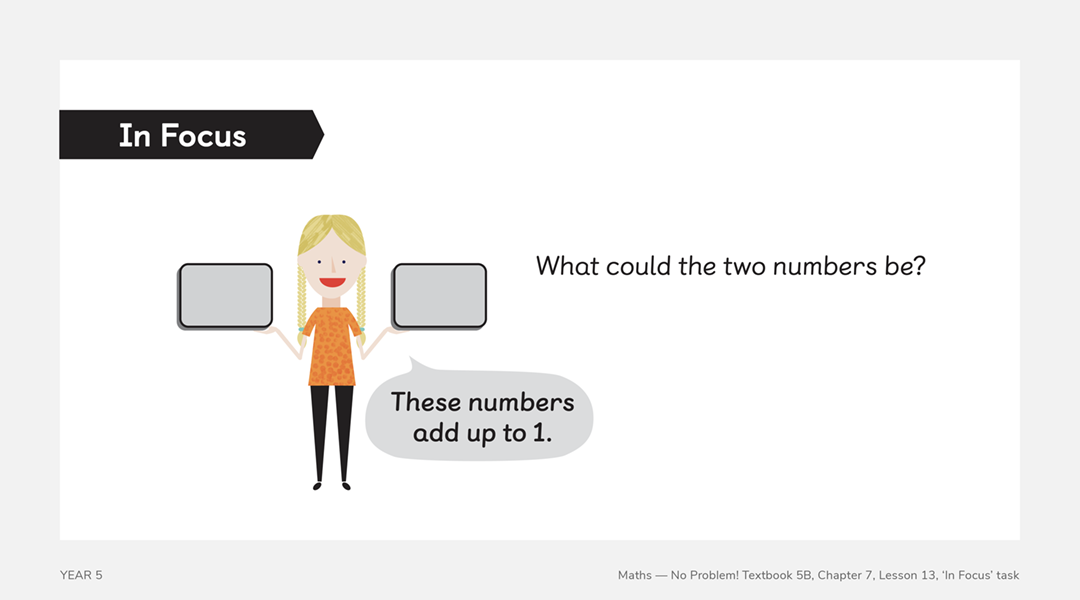
Writing Fractions as Decimals (Ages 9–10)
Lesson objective: Write fractions as decimals
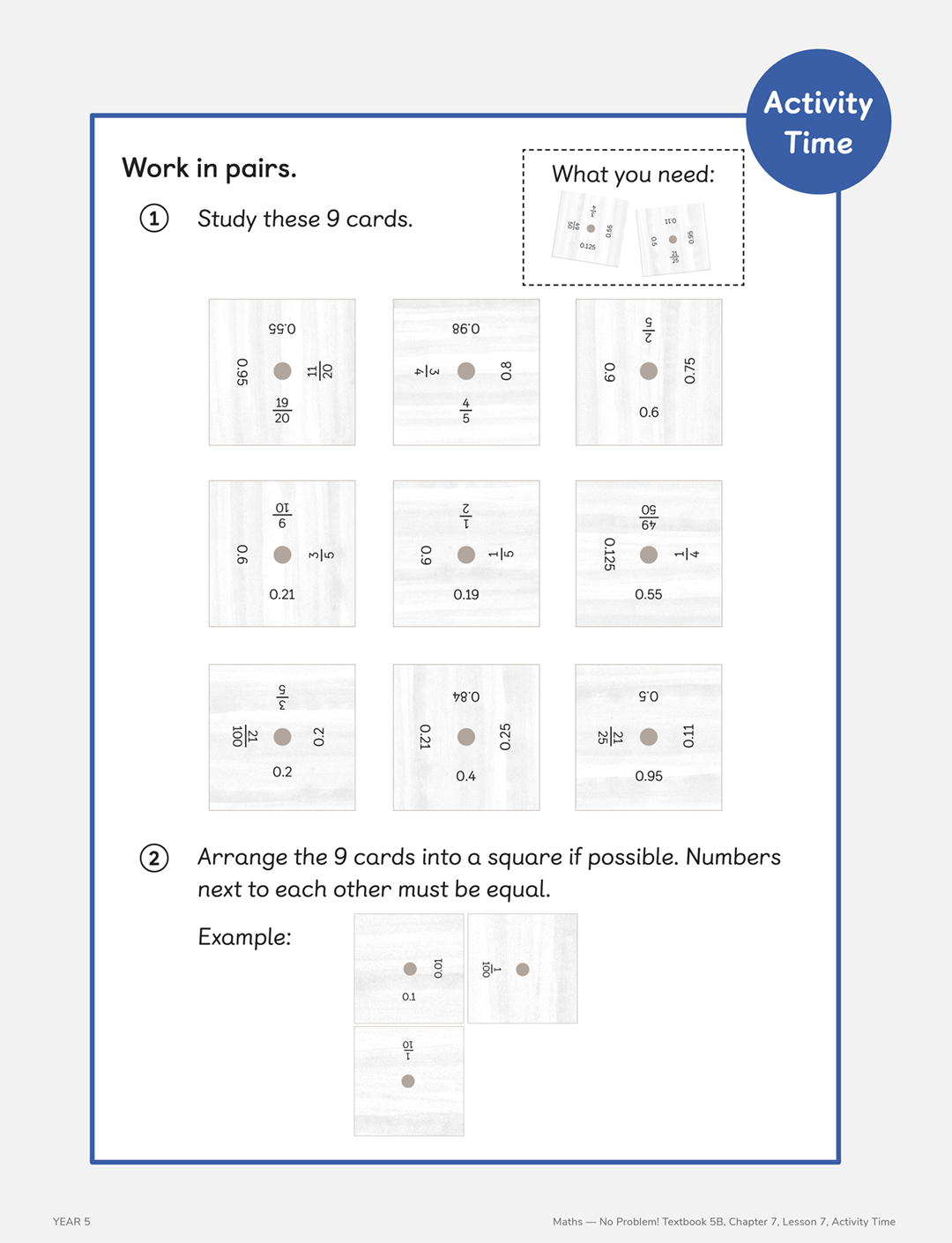
This activity focuses on converting fractions to decimals. You’re trying to see whether your child can convert denominators that are factors of 100 into hundredths. Can they write hundredths and tenths as decimals? Can they compare and order decimals with different denominators?
If your child finds this task difficult, adapt some of the fractions on the cards so they only focus on fractions with denominators of 10 and 100 to pair with the decimal. It might be helpful to use a number line as visual representation. Can they convert fractions to equivalent fractions with denominators of 10 or 100? Can they see 1⁄10 is equal to 10⁄100 and 0.1?
Challenge your child further by asking them to provide a written explanation on how to convert each fraction into an equivalent fraction with a denominator of 100. Encourage them to consider whether it would help to include symbols and pictures in their explanation.
Solving Problems Involving Angles (Ages 9–10)
Lesson objective: Solve problems that involve angles
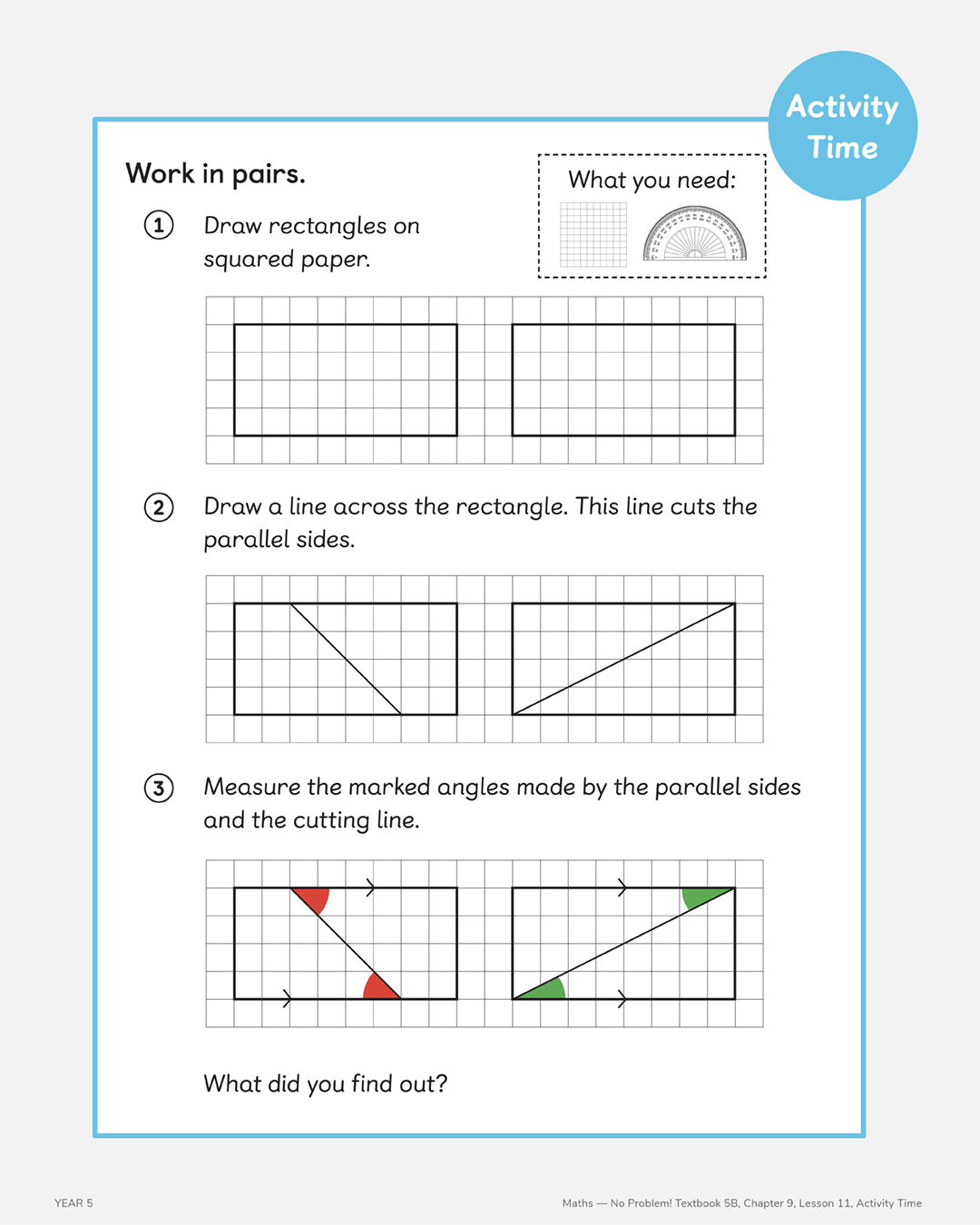
This activity explores angles in lines that cut parallel sides.
Ask your children to work in pairs and draw rectangles on squared paper. Ask them to draw a line across the rectangles to find vertically opposite angles and measure these angles. Ask questions like: what angles would be possible to find without a protractor?
They should understand that opposite angles are equal.
You can provide extra support by giving them a protractor to find missing angles and marking each angle as they progress.
To give your children more of a challenge, make sure that they explain how to calculate each angle.
Ages 10–11
Describing a Pattern (Ages 10–11)
Lesson objective: Generate and describe number patterns
This activity helps children recognise and describe which numbers work in the middle and why by asking the question: what is the pattern?
You can support your child by giving them the outlines in which to place the number cards and a table to record their solutions when they find them.
When they’ve found three solutions with the first set of numbers, ask them to use a similar pattern with the next set of numbers. Encourage them to work systematically.
If your child needs more of a challenge, allow them to try this activity with different sets of numbers, however, you must ensure they are 5 consecutive numbers (5 in a row).

Drawing Nets of 3-Dimensional Shapes (Ages 10–11)
Lesson objective: Recognise and make nets for 3-D shapes.

This activity helps children recognise and make nets for 3-D shapes. A net is a 2 dimensional figure that can be folded to make a three dimensional shape. You can start off by asking your child if they can identify some 2-D shapes? Can they list the number of 2-D shapes that make up 3-D objects around the house?
For struggling learners, this activity is designed to enable them to work with nets of 3-D shapes. Ask them if they are able to see the 2-D shapes and how they are attached. Can they count the number of faces on the triangular prism?
Add an extra challenge by seeing if your child can find a different net for the triangular prism (there are lots).
To extend this activity, ask your child to find boxes around the house. Can they open up the boxes to get the nets? Can they recognise the shapes and count how many similar shapes there are? Can they identify how many faces the 3-D shape has?
Drawing Nets of Three-Dimensional Shapes (Ages 10–11)
Lesson objective: Recognise and make nets for 3-D shapes
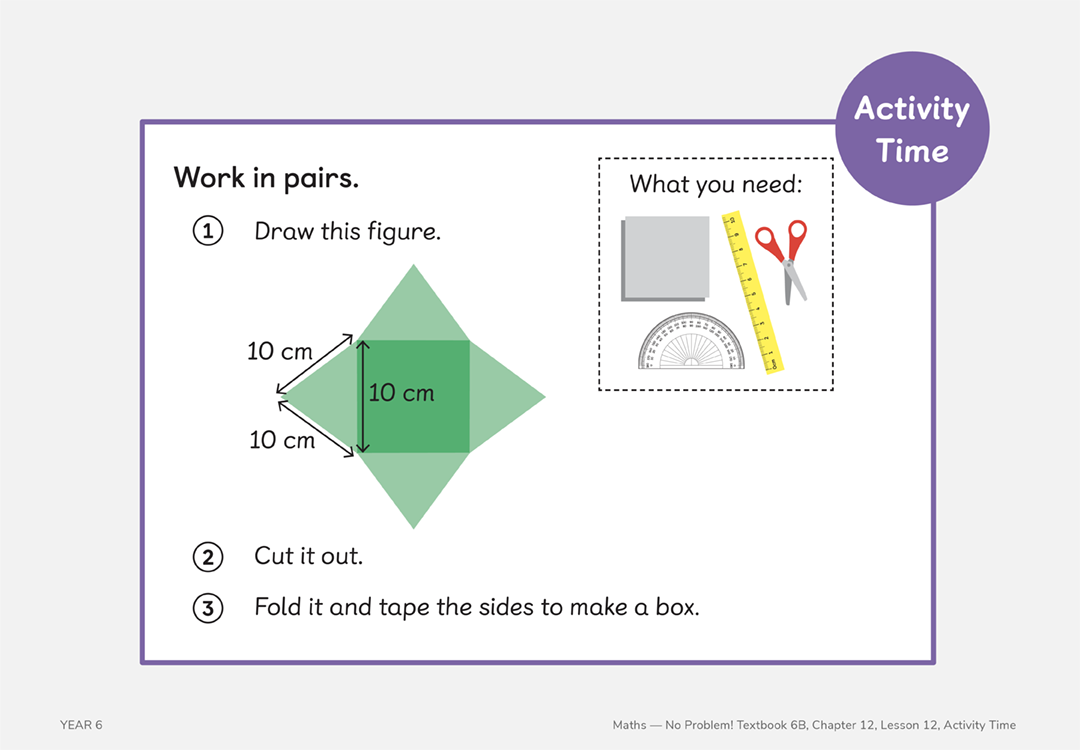
In this activity, you’re asking your children whether or not they can recognise, describe and build simple 3-D shapes, including making nets.
Encourage your children to work in pairs for this activity. Ask them to draw the net of the square pyramid, cut it out and tape it together to make the shape. Ask them to find as many nets as possible for the square pyramid.
Watch out for some common misconceptions in this activity:
Your child struggles to visualise how nets represent 3-D shapes. Your child struggles to see how nets fit together and which parts line up. Your child does not remember key terms: 'face', '2-D', '3-D', 'vertices' and 'edges'.
Learn the maths mastery basics
New to maths learning at home? World-renowned maths expert Dr Yeap Ban Har explains the maths techniques that help children develop a deeper understanding of abstract maths concepts.
What are the fundamentals?
Why are items only counted, added and subtracted if they have the same nouns? Dr Yeap Ban Har explains this fundamental maths idea
What’s the CPA approach
CPA stands for Concrete, Pictorial, Abstract. It’s where children learn new ideas through concrete experiences first, before drawing diagrams and writing abstract problems.
What are number bonds?
Learn how to explore number bonds with Dr Yeap Ban Har using concrete materials like counters, ten frames or with symbols.
How to teach bar modelling
Bar models help children represent known and unknown quantities. Explore why bar models help simplify difficult word problems.
Why mental strategies help with addition
Discover effective mental strategies to calculate the four operations (addition, subtraction, multiplication and division).
How to teach multiplication
What are the best multiplication strategies? Dr Yeap Ban Har explains how visualisation can support times tables in a meaningful way.

Never miss a parent resource
Interested in home learning resources delivered straight to your inbox? Sign up to our parent newsletter.
Helpful links for parents and caregivers
From the mastery how-to’s to quick tips and fun maths games — learn to support primary maths from home with confidence.
- 5 types of maths journals and how to use them
By Helly Douglas
- Making the most of bar modelling
By Judy Hornigold
- School from home: your maths learning resource round up
By Emily McIver
Ready to dive deeper into teaching maths for mastery? Read all of our blog posts here.

Structured Home Learning
Explore textbooks and workbooks. Free access to Answer Guides with every purchase.
Shop Now